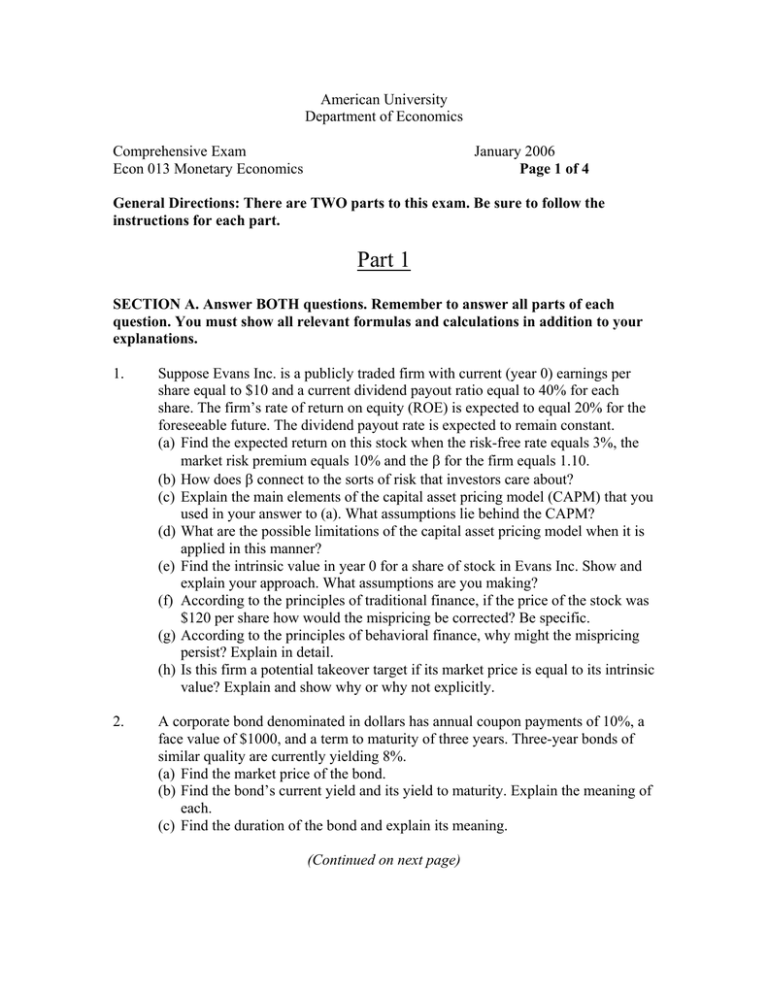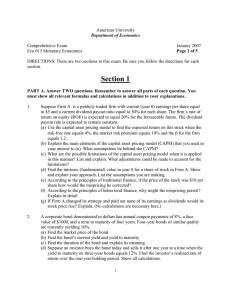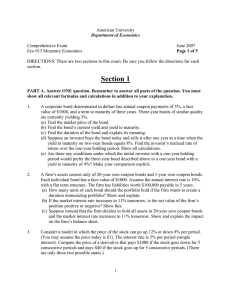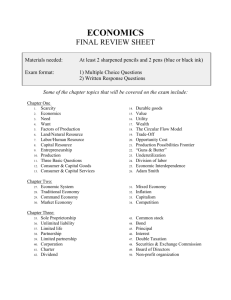American University Department of Economics Comprehensive Exam
advertisement

American University Department of Economics Comprehensive Exam Econ 013 Monetary Economics January 2006 Page 1 of 4 General Directions: There are TWO parts to this exam. Be sure to follow the instructions for each part. Part 1 SECTION A. Answer BOTH questions. Remember to answer all parts of each question. You must show all relevant formulas and calculations in addition to your explanations. 1. Suppose Evans Inc. is a publicly traded firm with current (year 0) earnings per share equal to $10 and a current dividend payout ratio equal to 40% for each share. The firm’s rate of return on equity (ROE) is expected to equal 20% for the foreseeable future. The dividend payout rate is expected to remain constant. (a) Find the expected return on this stock when the risk-free rate equals 3%, the market risk premium equals 10% and the β for the firm equals 1.10. (b) How does β connect to the sorts of risk that investors care about? (c) Explain the main elements of the capital asset pricing model (CAPM) that you used in your answer to (a). What assumptions lie behind the CAPM? (d) What are the possible limitations of the capital asset pricing model when it is applied in this manner? (e) Find the intrinsic value in year 0 for a share of stock in Evans Inc. Show and explain your approach. What assumptions are you making? (f) According to the principles of traditional finance, if the price of the stock was $120 per share how would the mispricing be corrected? Be specific. (g) According to the principles of behavioral finance, why might the mispricing persist? Explain in detail. (h) Is this firm a potential takeover target if its market price is equal to its intrinsic value? Explain and show why or why not explicitly. 2. A corporate bond denominated in dollars has annual coupon payments of 10%, a face value of $1000, and a term to maturity of three years. Three-year bonds of similar quality are currently yielding 8%. (a) Find the market price of the bond. (b) Find the bond’s current yield and its yield to maturity. Explain the meaning of each. (c) Find the duration of the bond and explain its meaning. (Continued on next page) Page 2 of 4 (d) Suppose an investor buys the bond today and sells it after one year at a time when the yield to maturity on two-year bonds equals 9%. Find the investor’s realized rate of return. (e) Are there any conditions under which an investor would prefer the three-year bond described above to a one-year bond with a yield to maturity of 10%? Make your comparison explicit. (f) Given the following (new) information on the term structure of zero-coupon bonds, find the price of the original three-year bond: yield to maturity on one year zero bonds = 5%, yield to maturity on two-year zero bonds = 7%, yield to maturity on three-year zero bonds = 10%. Show all calculations. What principle are you employing in this calculation? SECTION B. Answer ONE of the following questions. 3. Replicate a call option on a share of stock by finding how many shares to purchase (“a”) today and how much to borrow (“b”) at the risk free rate. Assume the spot price of a share of stock is $100 and in the future there are only two possible prices: $150 or $70. The risk free interest rate equals 10% and the strike price of the call option equals $100. Show the replication strategy carefully and be sure you find the price of the call option. 4. (a) Derive the put-call parity condition (you can use graphs or a table for this) and explain in detail how it relies on the “value additivity” condition. (b) Use the parity condition to carefully show how to replicate a share of stock. You must demonstrate each step completely. Page 3 of 4 Part 2 Instructions: Answer one question from Section A and one question from Section B. Read the questions carefully, and make sure to answer what is asked. Answers are judged on clarity of exposition and intuition, command of the relevant literature, and accuracy and depth of technical detail. Section A. Answer one question. 1. The Sidrauski and CIA models a. Explain Sidrauski’s approach to incorporating money into a model of economic growth, contrasting his approach with that of Tobin. b. How do households allocate their resources between money and consumption? (Refer to the equalization of marginal utilities). c. What is the steady-state capital-labor ratio in the Sidrauski model? Explain what it tells us about the neutrality of money. d. Is money super-neutral in the Sidrauski model? Explain why or why not. e. Explain how the cash-in-advance (CIA) model differs from Sidrauski’s approach. In the CIA model, what are the two constraints that households face in their optimization problem? f. In the CIA model, what does the marginal utility of consumption have to equal at its optimal level? g. What relationships define the capital-labor ratio and the level of consumption in the steady state? h. Is money neutral in the CIA model? Is it superneutral? i. Compare the Sidrauski and CIA approaches: What are their advantages and disadvantages? How compelling are their methods of incorporating money into the model? How consistent are their predictions with empirical evidence? 2. In the past two decades, flows of goods and capital between countries have increased in importance relative to world economic output. Some authors argue that these trends make it more pressing than ever for the world’s largest economies to coordinate their monetary policies. a. What does the new open-economy macro literature say on this subject: Are there welfare gains to be had from policy coordination? Describe the Obstfeld-Rogoff model, writing mathematical expressions for its basic set-up. Explain and evaluate the model’s implications for policy coordination. (Continued on next page) Page 4 of 4 b. Currency unions are another option for adapting monetary policies to a world of increased economic integration. According to Mundell’s model and recent work updating it, under what conditions would a group of countries find it beneficial to form a currency union? Explain. Section B. Answer one question. 3. Inflation targeting a. Define the problem of ‘time consistency’ and explain why, in the Barro-Gordon model, it causes ‘inflation bias.’ b. What is inflation targeting, and why is it thought to represent a good solution to the time consistency problem? c. What has been the experience among industrial countries with inflation targeting to date: Does it seem to have led to consistent reductions in inflation rates? What other factors have contributed to ‘quiescent inflation’ in recent decades? d. Does targeting inflation inevitably imply that monetary policy can no longer be used to offset aggregate fluctuations? Explain. e. There was initially considerable skepticism that inflation targeting would be suitable for emerging-market countries. Why? Explain in terms of complementary policies thought to be needed to go along with successful inflation targeting. f. If a country opts to target the domestic inflation rate, does this necessarily imply that it cannot control its exchange rate? Explain the trade-offs involved. 4. Banking crises a. Why was the U.S. so prone to experiencing banking crises in the period before 1933? Explain how the structure of the banking industry contributed to problems of bank instability. b. What factors have led to an upsurge in banking crises in the developing world in the past 20-25 years? c. What does economic theory tell us about the causes of banking crises? Compare and contrast theories based on self-fulfilling expectations vs. those that emphasize informational factors. Does either approach justify the use of deposit insurance to stop ineffcient bank runs? d. What does historical evidence on bank runs in the U.S. suggest: Are bank runs ‘sunspot’ phenomena? e. Explain Demirguc-Kunt and Detragiache’s analysis of the determinants of bank runs in the developing world. Do they find deposit insurance to increase or decrease risks of financial crisis? How do they interpret their result? What factors are omitted from their model that likely also contributed to banking crises in an era of financial liberalization?







